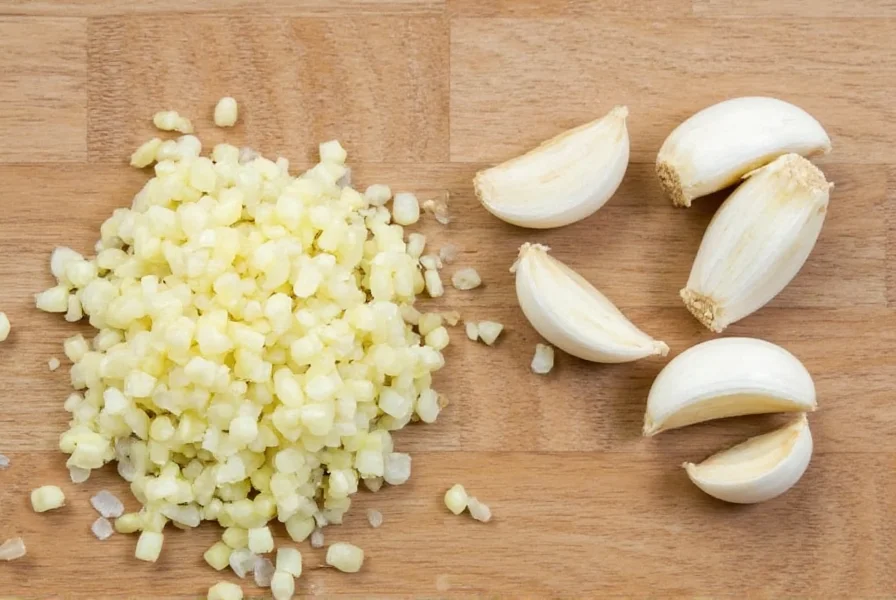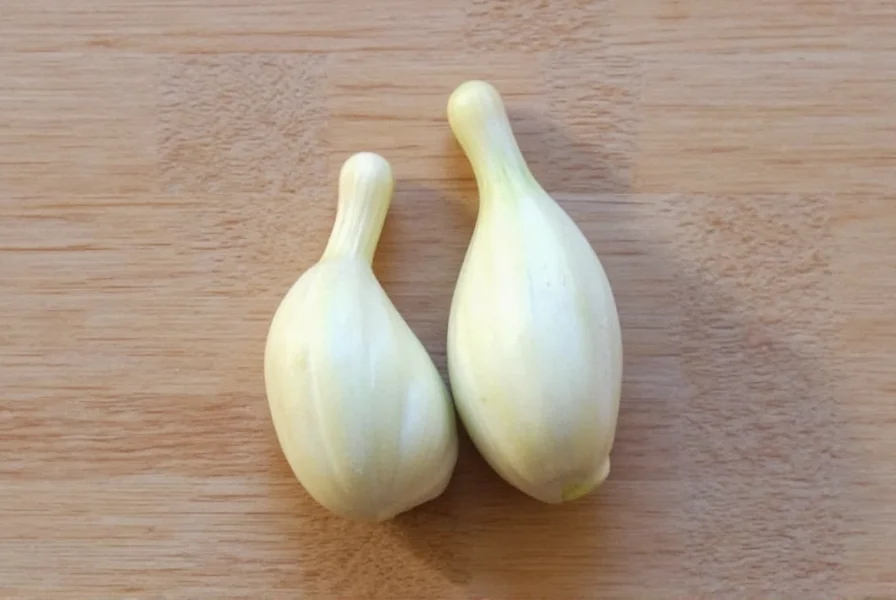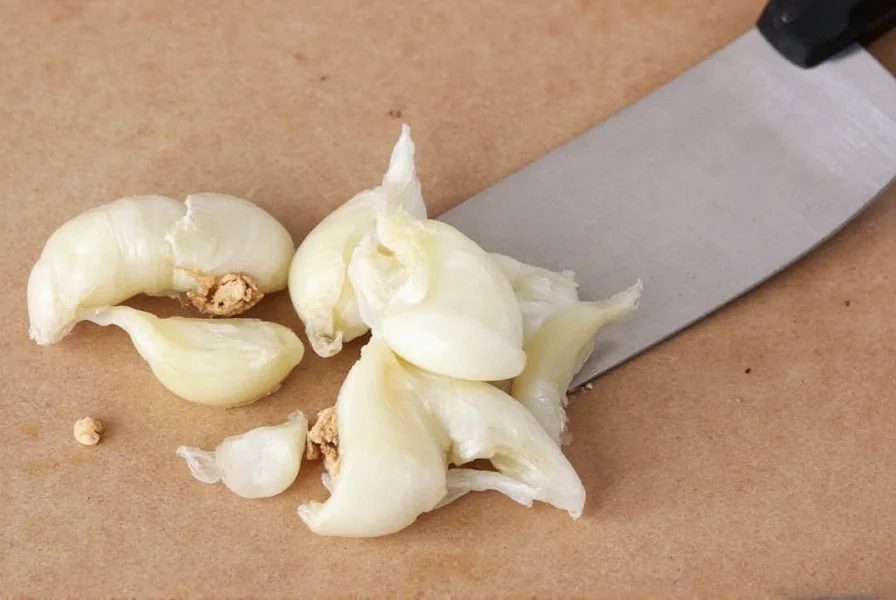When following recipes that specify garlic in cloves rather than measurements, understanding the exact conversion ensures consistent results. Two medium-sized garlic cloves, when properly minced, produce about 2 teaspoons of minced garlic. This standard conversion helps home cooks and professional chefs alike achieve the intended flavor balance in dishes ranging from Italian pasta sauces to Asian stir-fries.
Understanding Garlic Measurements
Garlic measurements can vary based on clove size and mincing technique. Understanding these variables helps you adjust recipes appropriately:
| Garlic Quantity | Minced Measurement | Equivalent in Recipes |
|---|---|---|
| 1 small clove | 1/2 teaspoon | Mild garlic flavor |
| 1 medium clove | 1 teaspoon | Standard garlic presence |
| 1 large clove | 1 1/2 teaspoons | Pronounced garlic flavor |
| 2 medium cloves | 2 teaspoons | Robust garlic flavor |
Factors Affecting Garlic Conversion
Several elements influence the precise conversion from whole cloves to minced garlic:
Clove Size Variability
Garlic cloves vary significantly in size. A single clove from a supermarket bulb might be twice the size of one from a farmer's market variety. When recipes specify "medium" cloves, they typically refer to cloves about 1 inch long and 1/2 inch in diameter.
Mincing Technique Matters
The method you use to mince garlic affects the final volume:
- Knife mincing: Produces slightly less volume due to compression
- Garlic press: Yields more volume with some liquid content
- Food processor: Can create a paste that compacts more densely

Practical Kitchen Application
Knowing that 2 garlic cloves equal approximately 2 teaspoons of minced garlic helps in several cooking scenarios:
Recipe Substitutions
When a recipe calls for minced garlic but you only have whole cloves (or vice versa), this conversion ensures proper flavor balance. For example, if a recipe specifies "2 tablespoons minced garlic," you would need approximately 6 medium cloves.
Batch Preparation
Many home cooks prepare garlic in advance. Understanding that 2 cloves yield 2 teaspoons helps determine how much to prepare for multiple recipes. Store minced garlic in an airtight container in the refrigerator for up to 5 days, or freeze in ice cube trays for longer storage.
Flavor Adjustment
Garlic intensity varies by freshness and variety. Older garlic may require slightly more volume to achieve the same flavor impact. When converting 2 garlic cloves to minced form, consider the garlic's age and adjust to taste, especially in delicate dishes.

When Precision Matters Most
While many recipes allow for garlic quantity flexibility, certain dishes require precise measurements derived from understanding how much minced garlic equals 2 cloves:
- Vinaigrettes and dressings: Where garlic can dominate other flavors
- Custards and delicate sauces: Where strong flavors become more pronounced during cooking
- Preserves and pickling solutions: Where acidity affects garlic's flavor development
- Raw applications like aioli: Where garlic's bite remains more intense
Common Measurement Mistakes to Avoid
Cooks often make these errors when converting whole garlic cloves to minced measurements:
- Not accounting for varying clove sizes between garlic varieties
- Measuring minced garlic before it's properly drained of juices
- Using heaping rather than level measurements
- Not considering that roasted garlic yields less volume than raw
Professional Chef Insights
Experienced chefs emphasize that understanding the conversion of 2 garlic cloves to minced form represents foundational kitchen knowledge. Many recommend developing a visual reference by mincing known quantities and observing the results. Over time, you'll recognize that 2 teaspoons of minced garlic creates a mound roughly the size of a walnut, helping you estimate without measuring tools when necessary.
How many tablespoons is 2 garlic cloves when minced?
Two medium garlic cloves yield approximately 2/3 tablespoon (or 2 teaspoons) of minced garlic. Since 3 teaspoons equal 1 tablespoon, 2 teaspoons is equivalent to two-thirds of a tablespoon.
Can I use jarred minced garlic instead of fresh cloves?
Yes, but adjust quantities as jarred minced garlic often contains preservatives and may have a milder flavor. For 2 fresh cloves (yielding 2 teaspoons minced), use approximately 1 1/2 teaspoons of jarred product, then adjust to taste.
Does roasting garlic change the measurement conversion?
Roasting garlic causes moisture loss and slight shrinkage. Two roasted cloves will yield about 1 1/2 teaspoons of minced garlic rather than the 2 teaspoons from raw cloves. The flavor becomes sweeter and less pungent, so you might need slightly more for equivalent garlic impact.
How can I tell if I've minced garlic finely enough for proper measurement?
Properly minced garlic should have no large chunks and resemble coarse sand. If pieces are too large, the volume will be greater but the flavor distribution will be uneven. For accurate measurement of 2 cloves' worth, mince until the pieces are uniformly small (about 1/16 inch).
Why does the conversion from whole cloves to minced garlic matter in recipes?
The conversion matters because garlic's surface area increases dramatically when minced, releasing more flavor compounds. Two whole cloves have less surface area than 2 teaspoons of minced garlic, which means the minced version will deliver significantly stronger flavor. Understanding this 2 garlic cloves to minced conversion ensures recipe consistency and proper flavor balance.











 浙公网安备
33010002000092号
浙公网安备
33010002000092号 浙B2-20120091-4
浙B2-20120091-4